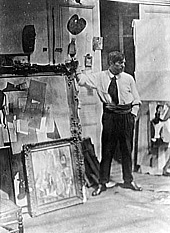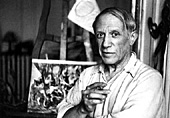“Painting isn’t an aesthetic operation. It’s a form of magic designed as the mediator between this strange, hostile world and us– a way of seizing power by giving form to our terrors as well as our desires.”
– Pablo Picasso
KERA: Let’s talk about one of Picasso’s most famous paintings: Les Demoiselles D’Avignon.

Pablo Picasso (© Photo RMN)
Yve-Alain Bois: Around 1906, Picasso discovered Matisse at a moment in time when Matisse was showing his painting The Joy of Life. When Picasso saw that particular painting, he was shocked, because what Picasso was doing at that time was much more academic. And Picasso said to himself, you know, ‘Oh, my God, I have to respond to that guy, I can’t let it go.’ And so what developed very quickly in his mind was the now-famous painting: Les Demoiselles d’Avignon.
In this painting, as I’ve said before, we realize that you don’t need to have one homogenous style within a painting; there is a recognition that painting is a language.
Picasso’s interest is in transforming something into something else. That is, anything can be the sign for something else. There is no one-to-one meaning. Anything can become a sign for a bull’s head: the combination of a bicycle seat and handlebar, for example. Anything can become transformed, and there’s a fundamental belief in the transformational character of art that is characteristic of all of his production.
KERA: Does Picasso use line and color differently from the ways in which Matisse uses them?
Rick Brettell: Picasso has this unbelievable natural ability with line and with draftsmanship, He is able to seduce you with that, as opposed to Matisse, who uses imagery to seduce you.

Pablo Picasso in Paris (© Bettmann/CORBIS)
And Picasso was never that interested in color. He’s not a great colorist. I mean, there are beautiful colors in paintings by Picasso, but they don’t make a contribution to color painting as such in the way that Matisse did. Picasso uses color for accent and for flavor. It’s important to the work of art, but it’s not essential to the work of art in Picasso. And it’s essential to the work of art in Matisse.
KERA: How do you think Picasso felt about his work?
Rick Brettell: Picasso always recognized that his main problem was that he was too talented, it was too easy. That’s why Picasso himself, in the end, disliked the so-called Rose period or Blue Period –because it was too sentimental and, you know, too easy to make and too easy to like.
Yve-Alain Bois: Picasso spoke several times about the fact that he had painted so many bad paintings. And he said it didn’t matter…He didn’t feel compelled to destroy them. He did destroy a couple of real turkeys, but in the end, you know, he didn’t edit that much.
Rick Brettell: With Picasso, you don’t see fifty drawings, forty-nine of which are eventually torn up. You see forty-nine different drawings. Each one is a theme in variation.
Yve-Alain Bois: When Picasso made a series of paintings, he always said that the painting he preferred was the one before the last, where things were not quite perfect yet, when he knew there was still something to do.

